By
The publishing houses of tango sheet music (First part)

ommunications nowadays are immediate. A message by electronic mail reaches the most far-distant places of the planet in a few seconds. Also radio, television, fax, cell phones are ways that carry information quite fast.
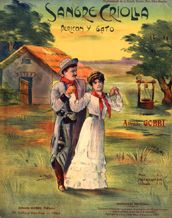 This was not like that by the end of the nineteenth century and for the first half of the twentieth century. By that time mail and telephone ruled communications and news spread slowly.
This was not like that by the end of the nineteenth century and for the first half of the twentieth century. By that time mail and telephone ruled communications and news spread slowly.
Not to mention the spreading of culture and, especially, music. Transmission was mainly oral, by word of mouth. Records and music players were not available to everybody and the radio in Argentina only appeared in the mid- twenties.
We are amazed by the great number and variety of old sheet music copies found with pieces and composers today unknown. Besides the pieces of composers of the level of Ángel Villoldo, Vicente Greco, Eduardo Arolas or Agustín Bardi there are others that never were recorded and we wonder what they were for.
Then we conclude that the printed sheet music was the instrument used to spread the pieces among musicians and the public in general.
That was its first purpose. The composer got in touch with a music publishing house to see if they were interested in his work. The publisher was no other thing but a trader in search of a financial benefit. If he thought that the number was interesting to be sold he printed or ordered to print a music staff, he added an illustration on the front cover and cared about advertising the piece. He later sold it or distributed it in the music or specialized houses so that it would be available for the public.
A documental attribute of the sheet music copy —when there were no record files for the copyrights of compositions— was providing certain legitimacy for the pieces.
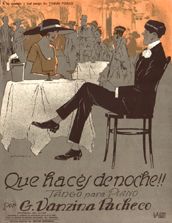 We can define a music publishing house as a person or enterprise that publishes by means of a printing press or other proceeding a piece of his own or belonging to third parties, written on a music staff in a great number of copies for spreading and sale.
We can define a music publishing house as a person or enterprise that publishes by means of a printing press or other proceeding a piece of his own or belonging to third parties, written on a music staff in a great number of copies for spreading and sale.
With the publishers two businesses were possible. The above of printing, sale and promotion of the piece or also, the sale of the copyright of the piece –partially or totally- that, despite the real authors were still known, their rights were transferred to the publishing house for a fixed amount.
The publishing houses with printing press were but a few. In the Antología del Tango Rioplatense there is a very interesting paragraph about it: «Music printers also had an outstanding position. They were the industry men in that active trade while the publishers were responsible for the published pieces and were the ones who sold them. In some cases, like in Breyer’s, the publisher owned a music printing press. Due to financial reasons the reverse process also took place: nearly all the printers began to be publishers. The most important of them was, undoubtedly, Ortelli Hermanos, the great printing firm of the period».
Semantically, a music part is a partial written form of a music piece. On it is represented one of the instruments or voices that form the complete work. In other words, the pianist has his part, the violinist, his like the bandoneon player, etc. When we talk of the full written part of a composition, involving all the instruments and voices, we refer to the “score” or “chart”.
Translator’s Note: But in this case we are talking of “sheet music”: a musical composition in printed or written form, or “piano music”: sheet music to be played on a piano. In modern popular music we also have a “lead sheet”: a sheet containing the words and melody for a song (and some indication of harmony) written in simple form.
Nowadays, sheet music for piano has lost some of its attributes, mainly, its capability of spreading music pieces. The ones who now make use of sheet music are musicians and amateurs.
There were hundreds of companies and people devoted to music publishing. Most of the pieces researched belong to the Bruno Cespi’s and to the Academia Nacional del Tango’s collections and were written for piano.
Below there is a listing of the music publishing houses published by the Instituto Argentino de Estudio sobre el Tango:
Manuel Aróztegui. Guayanas 480, Buenos Aires. He published his own pieces in the Roque Gaudiosi’s printing house (c. 1915).
M. Astengo, Lithography and Music Printer. Gaona 2332, Buenos Aires. He printed works for other publishers as from around 1905; and as publisher as from 1920, approximately.
Juan S. Balerio, Publisher. Bulnes 951, Buenos Aires. He published in the Ortelli Hnos. printing house as from 1909. In the twenties the firm moved to Salguero 1175 and published sheet music in cheap editions; later they were succeeded by Editorial Balerio y Bonini.
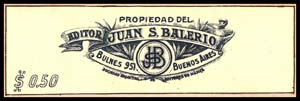
J. M. Baña y Cía., Publishers. Rivadavia 853, Buenos Aires. Heirs of Sprunck y Cía., an old piano deposit, they published tangos in the Ortelli’s printing house between 1905 and 1910, approximately.
Baña, Lottermoser y Cía. Company that followed the above, it published tangos between 1912 and 1915. In the 20s the firm was run by Carlos Lottermoser under the name “Casa Lottermoser”; It disappeared in the late 60s when it was the oldest music house in Buenos Aires.
A. F. Belaúnde y Cía. Florida 243, Buenos Aires. They sold pianos and printed music and published between 1905 and 1920, in some cases in the printing house run by Ortelli Hnos.
José Bonfiglioli., Edición Casa “Beethoven”. In 1909 on Callao 109, Buenos Aires. Later on Victoria 1632; around 1918 it published in the Ortelli Hnos’ printing house.
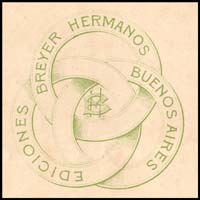 Breyer Hnos., Publisher. It is one of the main music publishing houses in the history of our country. It was founded in 1882. It was originated in the Casa Neumann & Breyer, agents for Bechtein & Neumann pianos. By the end of the nineteenth century it was located on Corrientes 627, Buenos Aires; at the beginning of the twentieth century on Florida 49/51 and a little bit later on Florida 414. An address that, with the passing of time, would become one of the most well-known in the music trade of the city. The house had printing workshops on Bolívar 1620 and opened branches in the main cities of the country. In 1924 the publishing house and the music printing press were bought by Ricordi of Milan. The former was agent of the latter from around 1885. Breyer then continued with the sale of pianos and musical instruments and shared with Ricordi the building on Florida 414. It published tangos from the beginning of the twentieth century with its series of “Tangos Criollos” and in a great number of single publications with a printing of high quality that have the most beautiful front covers for this popular genre ever made.
Breyer Hnos., Publisher. It is one of the main music publishing houses in the history of our country. It was founded in 1882. It was originated in the Casa Neumann & Breyer, agents for Bechtein & Neumann pianos. By the end of the nineteenth century it was located on Corrientes 627, Buenos Aires; at the beginning of the twentieth century on Florida 49/51 and a little bit later on Florida 414. An address that, with the passing of time, would become one of the most well-known in the music trade of the city. The house had printing workshops on Bolívar 1620 and opened branches in the main cities of the country. In 1924 the publishing house and the music printing press were bought by Ricordi of Milan. The former was agent of the latter from around 1885. Breyer then continued with the sale of pianos and musical instruments and shared with Ricordi the building on Florida 414. It published tangos from the beginning of the twentieth century with its series of “Tangos Criollos” and in a great number of single publications with a printing of high quality that have the most beautiful front covers for this popular genre ever made.
César Canulli, Publisher. Cangallo 1781, Buenos Aires. He published in the Gaudiosi’s printing house (c. 1920).
A. Carrano, Publisher. Piedad 947, Buenos Aires. He had published since the beginning of the twentieth century. In the 20s he was domiciled on Riobamba 439.
Enrique Caviglia, Publishers. Also: Ediciones Mignon. In the early days of the twentieth century on Aguirre 334, Buenos Aires and later on Álvarez 579 (c. 1910).
J. V. Cianciarulo, Publisher. Pasco 540, Buenos Aires. He published in the Ortelli Hnos’ printing house between 1905 and 1915.
Drangosch y Beines, Publisher. Bartolomé Mitre 1032, Buenos Aires. This important house may have published only tangos by Ernesto Drangosch around 1915.
Editorial Autores Unidos. Bogotá 3024, Buenos Aires (c. 1920).
Juan Feliú e Hijos, Publishers and Printers. Around 1920 when they started their publishing trade they were domiciled on Carlos Pellegrini 440, Buenos Aires, next to the Casa Baña, as the advertisements said. In the following decades it became an important publishing house of cheap tango editions.
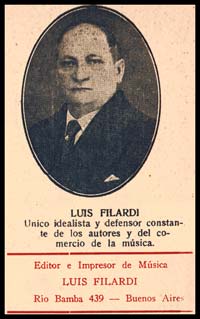 Luis Filardi, Publisher. It was located on Suipacha 374, Buenos Aires at the beginning of the twentieth century. Later its house was on Bartolomé Mitre 2288 and on Bolívar 1546 around 1920. Through his own editions we can be aware of some aspects of this publisher. On the back cover of one of his printings (20 cents for the cheap edition and 60 cents for the deluxe one) you can read: «Our cheap editions include an extensive new, successful repertoire which can be evidenced with the 800.000 numbers sold last year». Later in 1932 in another cheap edition of tango he introduced himself as: «Author-Publisher-Printings-Industrial since 1900». The publisher Carrano —who seems the one in possession of Filardi’s rights— announced by the same time: «Unique repertoire chosen by the oldest publisher of the Guardia Vieja. Mr.Luis Filardi, Author, Publisher, Printer since 1900».
Luis Filardi, Publisher. It was located on Suipacha 374, Buenos Aires at the beginning of the twentieth century. Later its house was on Bartolomé Mitre 2288 and on Bolívar 1546 around 1920. Through his own editions we can be aware of some aspects of this publisher. On the back cover of one of his printings (20 cents for the cheap edition and 60 cents for the deluxe one) you can read: «Our cheap editions include an extensive new, successful repertoire which can be evidenced with the 800.000 numbers sold last year». Later in 1932 in another cheap edition of tango he introduced himself as: «Author-Publisher-Printings-Industrial since 1900». The publisher Carrano —who seems the one in possession of Filardi’s rights— announced by the same time: «Unique repertoire chosen by the oldest publisher of the Guardia Vieja. Mr.Luis Filardi, Author, Publisher, Printer since 1900».
José Felipetti, Publisher. Charcas 2288, Buenos Aires. Approximately between 1905 and 1910 he published tangos and other numbers he had written in the Ortelli Hnos. and the M. Astengo printing houses. Around 1918 he was located on Costa Rica 4372 and published tangos of several composers in the Ortelli’s printing house.
Source: Veniard, Juan María: Instituto Argentino de Estudios sobre el Tango, Appendix 4, Editores de música de tango-Tango music publishers.